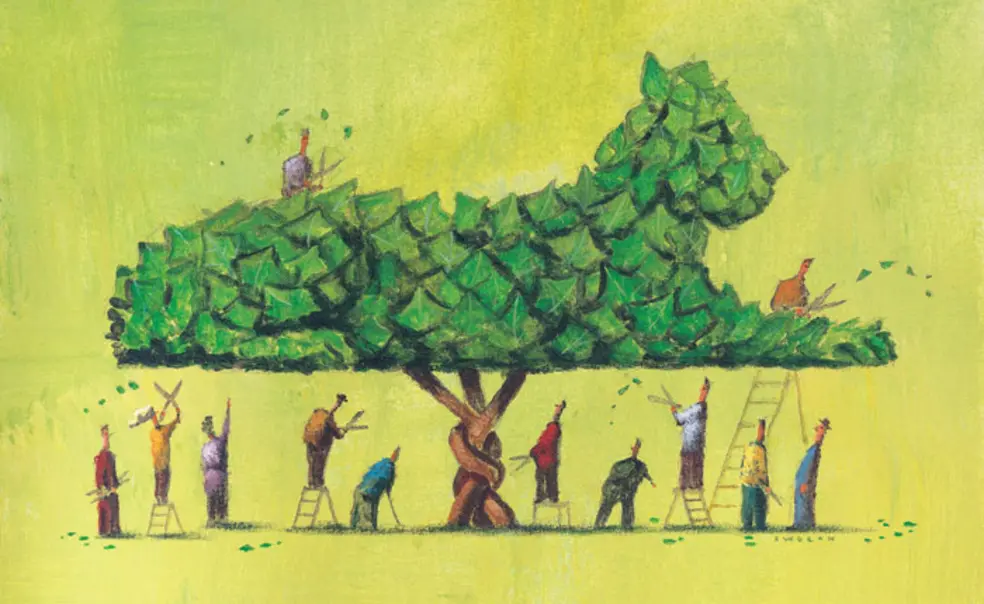Twelve who shaped Princeton
Scholars, writer, philanthropist, and activist--they all helped make Old Nassau what it is today.
Woodrow Wilson 1879: Wilson made Princeton — without him, the university we know today simply would not exist. In eight tumultuous years as president he took a sleepy college (a university in name only) that was adrift and losing ground to old rivals like Yale and Harvard and to new schools like Johns Hopkins and Chicago, and turned it into a major institution of higher learning. A charismatic professor of politics, Wilson assumed the presidency in 1902, replacing the lackluster Francis L. Patton.
His sweeping reforms touched every aspect of campus life. He raised academic standards, organized the faculty into departments, and reformed the curriculum, replacing a haphazard system of electives with a structure requiring juniors and seniors to concentrate their studies in a single department. Most famously, Wilson introduced the preceptor system and hired 50 new assistant professors to staff it — in a stroke doubling the size of the faculty. Wilson’s “preceptor guys” included many of the nation’s brightest young scholars.
Wilson fell short in his efforts to create a system of undergraduate residential colleges (the so-called Quad Plan, which alumni opposed out of concern that it would undermine the eating clubs) and to build a graduate college in the center of campus, with the notion that a critical mass of graduate students in their midst would elevate the minds of undergraduates. The latter pitted Wilson against Dean Andrew Fleming West 1874, who wanted the Graduate College off campus to keep graduate students sequestered from the frivolities of undergraduate life. West prevailed.
The Wilson-West struggle split the faculty and trustees and led to Wilson’s resignation in 1910. But his vision endured. Wilson wanted Princeton to be a major research university that was small in size, residential in character, grounded in the liberal arts and sciences, and devoted to undergraduate teaching. And that is the university it became.
Henry B. Fine 1880: Princeton’s preeminence in mathematics and the physical sciences can be traced directly to Dean Fine, a professor of mathematics. Wilson didn’t much care about math and science but knew they were important, and he delegated to his friend “Hank” Fine the job of recruiting a first-rate faculty in these fields. Fine attracted a cadre of young stars — dubbed “Fine’s research men” — who elevated Princeton’s academic standing at home and abroad. In 1921, on his first visit to the United States, Albert Einstein made a point of lecturing at Princeton as a nod to the faculty’s early support of his theories.
Andrew Fleming West 1874: West, a professor of classics who held no graduate degree, was dean of the Graduate School from 1901 to 1928. His monument is the Graduate College, a splendid and literally towering example of his beloved collegiate gothic architecture overlooking Springdale Golf Course, more than half a mile from the center of campus. The college’s physical remoteness symbolizes, and reinforces, the divide between graduate and undergraduate life at Princeton — West’s legacy, for better or worse.
John G. Hibben 1882: A professor of philosophy respected for his quiet authority, Hibben (president, 1912–32) healed the breach between the Wilson and West camps, telling alumni, “I represent no group or set of men ... but the united Princeton.” Introduced in 1923, his Four-Course Plan reduced the number of courses per semester from five to four for juniors and seniors — with the concomitant requirement that they engage in independent work (two junior papers and a senior thesis) and pass a departmental exam at the end of senior year. All three of Princeton’s professional schools — engineering, architecture, and public affairs — were established during his tenure.
Harold W. Dodds *14: Dodds, a professor of politics who served as president from 1933 to 1957, guided Princeton through the upheavals of the Great Depression and World War II and oversaw a postwar expansion marked by a near doubling of the faculty and the construction of Firestone Library and development of the Princeton Forrestal campus. He instituted curricular reforms that for the first time imposed distribution requirements, compelling students to take courses across the range of disciplines. Dodds’ last decade saw a significant broadening of student demographics, with more students from public high schools, fewer from prep schools, and an end to Princeton’s de facto (and never acknowledged) quota on Jews.
Robert F. Goheen ’40 *48: Goheen was a 37-year-old professor of classics when he moved into One Nassau Hall in 1957, for what would be a 15-year term. Wilson excepted, no modern president has had more impact on Princeton. Goheen steered Princeton through the tremors of the Vietnam era and ended mandatory chapel for freshmen and “parietals,” the irksome in loco parentis rules for undergraduates. His academic innovations included student-initiated seminars and the introduction of pre-exam reading periods. Goheen nurtured the Woodrow Wilson Society, a residential and dining alternative to the eating clubs and a harbinger of today’s residential college system. He pursued an aggressive policy of affirmative action that boosted enrollment of blacks from two or three per class to nearly 10 percent of the student body. Most important, and in the face of initial trustee and alumni opposition, he led the way in Princeton’s historic decision to admit women.
William G. Bowen *58: A professor of economics and former provost, Bowen, in his 16 years as president (1972–88), left his mark with several farsighted initiatives. He created five residential colleges for freshmen and sophomores, a move that brought the University closer to realizing Wilson’s Quad Plan. In academics, Princeton lagged in the fast-moving field of molecular biology; in just a few years, and more or less from scratch, Bowen built a world-class program, recruiting top researchers (including future president Shirley M. Tilghman) and setting them up in two new state-of-the-art laboratories.
Harold T. Shapiro *64: Another economist, Shapiro left the presidency of the University of Michigan to head Princeton. During his 13 years in office (1988–2001) he enhanced undergraduate teaching and expanded financial aid by replacing loans with direct grants. Shapiro also broadened the scope of financial aid by offering it to international students. Updating Wilson’s famous phrase, he committed Princeton not only to “the nation’s service” but to “the service of all nations.” He launched a five-year capital campaign that was Princeton’s first to raise more than a billion dollars and paid for many new programs and facilities, including the Frist Campus Center.
Laurance S. Rockefeller ’32: Alumni have contributed billions of dollars to Princeton, but few have done so in a more timely or strategic way. When Goheen needed new dormitories to make coeducation possible, Rockefeller, a charter trustee at the time, came forward with $4 million. His largesse was critical to Princeton’s entry into molecular biology (he underwrote construction of Lewis Thomas Laboratory) and establishment of the residential colleges (one of which is named for his brother, John D. III ’29). Rockefeller’s munificence also funded the Forrestal campus, the University Center for Human Values, seven professorships, two preceptorships, and innumerable scholarships and fellowships.
F. Scott Fitzgerald ’17: Princeton has had a love-hate relationship with Fitzgerald, a prodigal son and its most famous dropout, since the 1920 publication of his exuberant novel of campus life, This Side of Paradise, catapulted him to fame — and branded Princeton, in Fitzgerald’s words, “the pleasantest country club in America.” It was a characterization, however exaggerated, that took the University decades to overcome. But his paean to the lush green campus with its spires and gargoyles and “riot of Gothic architecture” touched a romantic chord and inspired statesman George F. Kennan ’25 and biographer A. Scott Berg ’71, among others, to attend.
Sally Frank ’80: After Princeton became coeducational in 1969, all but three of its eating clubs — Ivy, Cottage, and Tiger Inn — welcomed women. Ten years later, junior Sally Frank sued the holdouts for discrimination when they refused to let her bicker. With remarkable tenacity and aplomb, Frank pursued her case through the courts for the next 13 years. Cottage dropped its defense in 1986, followed by Ivy and Tiger in 1991 and 1992, thus ending one of the last vestiges of Fitzgerald’s Princeton.
John Maclean Jr. 1816:
J.I. Merritt ’66, a freelance writer, is a former editor of PAW.













No responses yet